Laser Tattoo Removal
 Has that tattoo you got in your twenties lost some of its appeal? That’s okay. Laser tattoo removal is used to eliminate, lighten, or correct unwanted body art. The procedure involves a series of treatments designed to remove the deep penetrating ink. Results can vary depending on the placement of the tattoo, the colors used, and your skin tone. Muskegon Laser Tattoo Removal is a division of MSA – Plastic Surgery.
Has that tattoo you got in your twenties lost some of its appeal? That’s okay. Laser tattoo removal is used to eliminate, lighten, or correct unwanted body art. The procedure involves a series of treatments designed to remove the deep penetrating ink. Results can vary depending on the placement of the tattoo, the colors used, and your skin tone. Muskegon Laser Tattoo Removal is a division of MSA – Plastic Surgery.
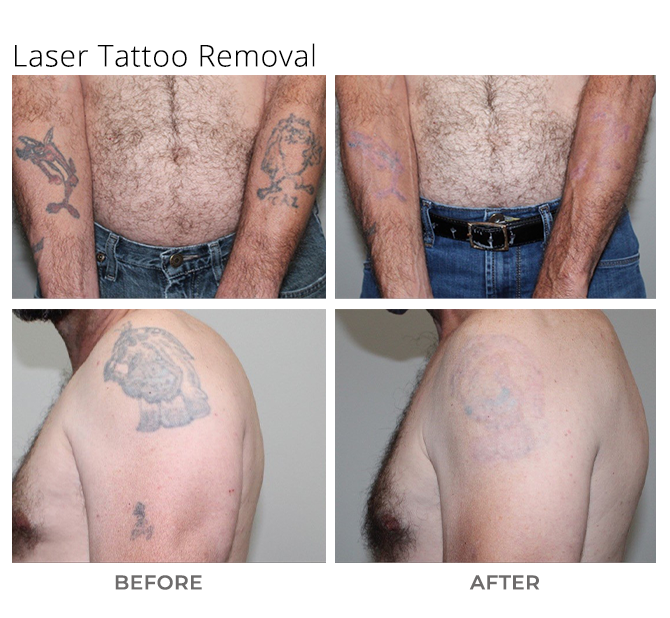
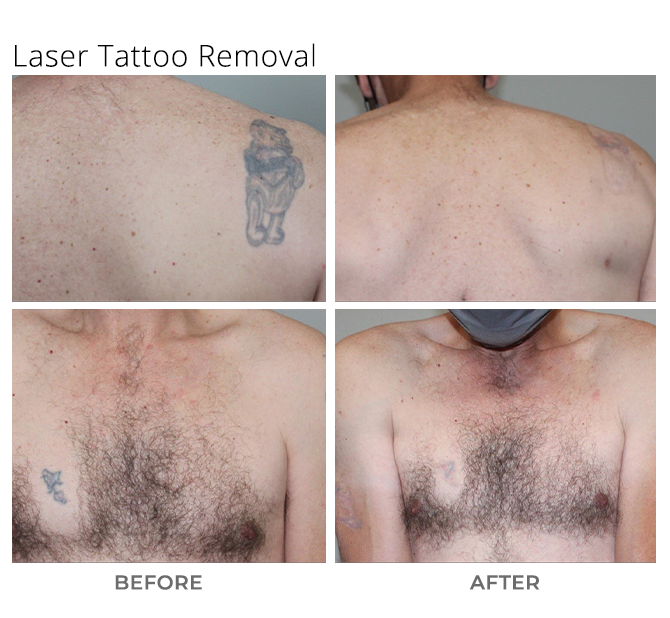
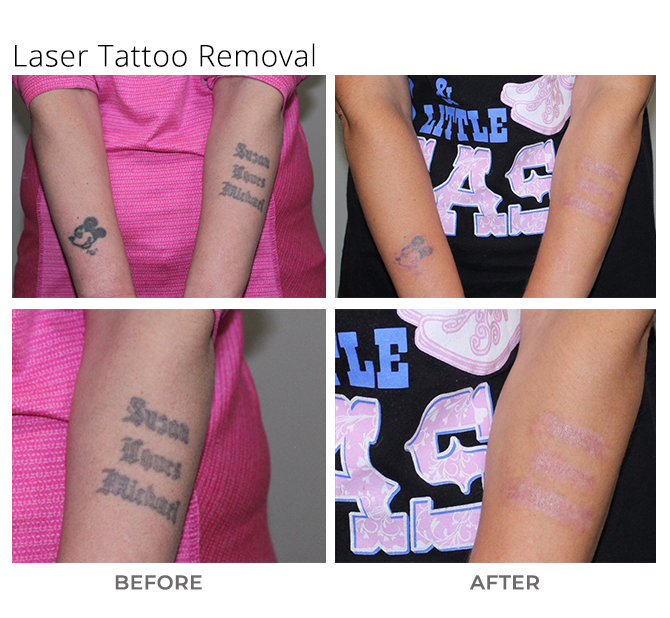
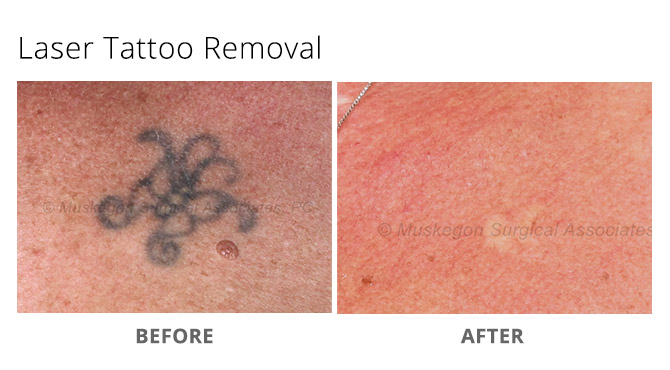
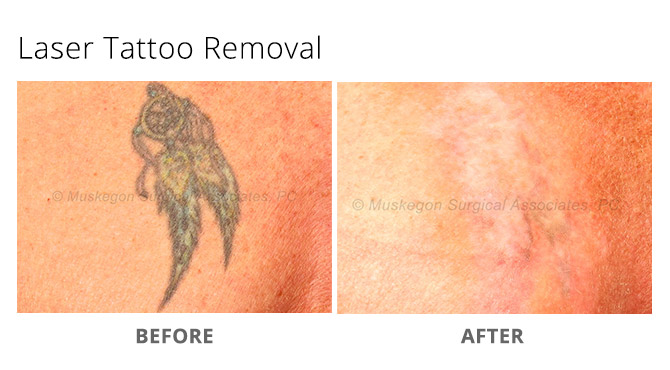


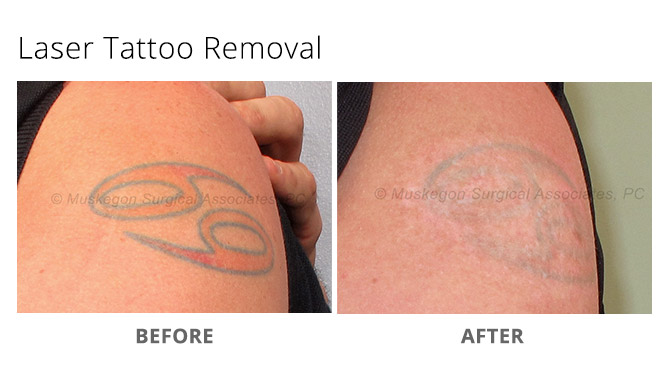
Overview
What Seemed Like a Great Idea at the Time, May Have Lost Some of It’s Appeal Over the Years!
Muskegon Surgical Associates offers the best results for tattoo regret throughout Muskegon, Grand Haven, Grand Rapids, Ludington, and beyond. Whatever your removal reason is, our Board Certified Plastic Surgeons and advanced Astanza Trinity laser can get rid of your tattoo in the fewest amount of treatments possible.
During your treatment session, our Astanza Trinity laser emits intense, ultra-quick pulses of light energy. The wavelengths of light safely penetrate through the skin and selectively target the ink particles trapped in your skin’s deepest layer, the dermis. The ink particles absorb the light energy, heat up, and shatter into tiny fragments, leaving all surrounding skin tissue unharmed. The fragmented ink particles are then collected by the blood cells and naturally disposed through the lymphatic system.
Multiple sessions are needed to successfully break down the tattoo and speed up the natural fading process. Each tattoo has varying layers of ink particles. The laser breaks down the shallowest layers and works its way down with each following treatment session. Over a series of treatments, your tattoo will gradually fade until you reach your desired ink clearance. Our clinic uses the Kirby-Desai Scale to access the potential success and number of treatments your unique tattoo will need.
Muskegon Surgical Associates delivers complete tattoo removal, partial or selective tattoo removal, and lightening or fading for tattoos in preparation for a cover-up tattoo. Our clinic utilizes the latest in laser technology to ensure your skin receives its desired look. Patients will see results after just a few treatments – no matter their skin type or tattoo color!
Technology
The Astanza Trinity
Muskegon Surgical Associates uses the latest state-of-the-art laser technology on the market. Our investment in the Astanza Trinity laser is a testament to the dedication we have for our patients’ results. The Astanza Trinity laser is the most powerful triple-wavelength laser in the tattoo removal industry and is widely trusted by leading tattoo removal practitioners and physicians worldwide.
The Astanza Trinity is a combination system that features two stand alone technologies, a Q-switched Nd:YAG laser and a Q-switched Ruby laser. Together, these systems create the Trinity and emit a total of three versatile wavelengths: 1064 nm, 532 nm, and 694 nm. The more wavelengths a laser has, the more colors it is able to treat. Each wavelength of light energy is selectively absorbed by a specific group of ink colors. Laser tattoo removal is only successful when a tattoo pigment particle absorbs light energy. If the wrong wavelength is used, then the pigment particle will reflect the light energy and remain trapped in the skin. Here is a breakdown of the colors each of Trinity’s wavelengths targets:
- 1064 nm: black, brown, and dark blue inks
- 532 nm: red, orange, yellow, and violet inks
- 694 nm: vivid blue, turquoise, teal, and bright green inks
Many clinics only support two wavelengths and are limited to the number of tattoo colors they can treat, namely black and red inks. Our Astanza Trinity’s 694 nm ruby wavelength specifically targets resistant blue and green shades that are considered untreatable with traditional dual-wavelength lasers.
Furthermore, our Astanza Trinity produces ultra-quick pulse durations and higher pulse energies for greater peak power and optimal ink shattering. Clinics that use dye handpieces to generate more wavelengths are actually cutting down their pulse energy, making it difficult to shatter any ink.
Our Astanza Trinity is specially designed to eliminate more ink with each treatment and deliver faster results. Thanks to this cutting-edge technology and our expert Board Certified Plastic Surgeons, Muskegon Surgical Associates provides unmatched results throughout the Greater Muskegon area, Holland, Grand Haven, and beyond.
The Zimmer Cryo
Laser tattoo removal is a highly tolerable and very fast procedure. However, some patients are still concerned about the laser’s sensation. At Muskegon Surgical Associates, our main priority is the comfort of our patients. That is why we have invested in the ultimate skin chiller, the Zimmer Cryo.
The Zimmer Cryo cooling machine is a noninvasive cooling device that uses freezing cold air to numb the skin. Similar to an air conditioner, the Cryo uses a hose and different levels of air pressure at a temperature of -30ºC to effectively and safely numb the skin. It only takes a few minutes to completely numb the skin and prepare it for treatment. For smaller tattoos or tattoos that only need a specific portion removed, the Zimmer Cryo features a precision tip for more accurate targeting.
The best attribute about the Zimmer Cryo cooling device is its ability to numb the skin during treatment. Unlike ice packs and topical creams that wear off quickly and can only be applied before and after treatment, the Zimmer Cryo’s simple design allows for maximum comfort before, during, and after treatment. Muskegon Surgical Associates patients can even hold and direct the hose for more control over their skin’s comfort.
Come in for a consultation to learn more about our technology and test it out for yourself!
FAQs
How many treatments will I need?
The average number of treatments a patient needs ranges between 5 and 10. Patients with older or faded tattoos usually require around 3 to 4 treatments. Muskegon Surgical Associates uses the Kirby-Desai Scale to best determine the number of treatments you will need. Due to the varying layers of ink in a tattoo, tattoo removal is not typically a one-time treatment. Because every tattoo is different, various factors will affect how many sessions you will need. Some of these factors include:
- Age of tattoo
- Location of tattoo
- Ink Density
- Ink Colors
- Skin Type
- Patient Health
- Pre-existing scarring
How long before I see complete removal?
Since every tattoo is unique and since every patient heals at different rates, there is no way to determine the exact duration it will take to completely remove your tattoo. Treatment sessions are spaced a minimum of 4 to 8 weeks apart to allow enough time for your skin to heal before its next laser session. That being said, some patients may experience complete removal after a few months while others may take over a year. The same factors we use to determine the number of treatments you will need also play into how long it will take to completely remove your unwanted ink. Our Astanza Trinity laser is designed to eliminate more ink with each session, speeding up that natural fading process and minimizing the number of overall treatments needed.
Does the laser hurt?
Many patients compare the laser sensation to a rubber band being snapped against the skin. Others say it is comparable to having a tattoo applied. Whatever your pain tolerance is, the overall procedure is very tolerable. Luckily, laser tattoo removal is a very quick procedure that lasts anywhere from 30 seconds to 30 minutes depending on the size of the tattoo receiving treatment. Muskegon Surgical Associates provides skin numbing before, during, and after treatment featuring the Zimmer Cryo Cooling Device.
Are there side effects?
Laser tattoo removal is the safest method for removing unwanted ink. Our Board-Certified Plastic Surgeons use protocols that are tailored to your unique skin type and tattoo to ensure your skin receives optimal results. The most common side effects experiences are redness, swelling, itchiness, scabbing, blistering, and skin pigmentation changes. These side effects are temporary and heal over the weeks following a treatment. Patients are encouraged to follow proper aftercare instructions outside of our clinic to generate the best results for their skin.
Can you lighten my tattoo for a cover-up?
Absolutely! Our Astanza Trinity laser performs complete ink removal, partial removal of a tattoo, and fading of ink for tattoos in preparation for a cover-up tattoo. Cover-up tattoos are a popular solution for dealing with unwanted ink. However, many tattoo artists have difficulty covering up existing artwork that contains a lot of dark ink. To successfully mask an original design, tattoo artists tend to use twice the amount of ink. Lightening a tattoo allows cover-up artists to use less ink and also gives them more flexibility with their design. A faded tattoo acts more like a blank canvas than a tattoo with lots of heavy and dense ink. Most patients only require 1 to 3 treatments for successful lightening.
Aftercare
Muskegon Surgical Associates strongly advises patients to follow proper aftercare instructions following each session. Our Board-Certified Plastic Surgeons and industry-leading Astanza Trinity laser promise to provide the safest protocols and unmatched treatments, however, it is your responsibility to care for your skin outside of our clinic. Proper aftercare is the most important step to ensuring clear skin and ink-free results. These steps help fight against unwanted infection and prevent more serious side effects from developing. All patients will receive a take home aftercare instruction sheet. Below are just a few aftercare tips to keep in mind and prepare for.
- Showers can be taken as long as high pressure water does not hit the treatment site. All other soaking activities – baths, pools, hot tubs, etc. – should be avoided at all costs to reduce the chance of infection.
- Blisters and scabs are a common side effect to laser treatment. Though unsightly, these side effects are positive and natural reactions to the healing process. If blisters or scabs form, protect the area and allow them to pop or flake off on their own. Never prematurely pick or pop a blister or scab. Doing so can lead to infection and permanent side effects, like scarring. Once a blister or scab has naturally popped/flaked, wait 24 hours before applying an antibiotic ointment.
- Cold compresses can be applied to the treatment site after a session. This helps reduce any discomfort and inflammation.
- Tylenol or Motrin may also be taken for added comfort, however, Aspirin should be avoided as it can increase risks of bruising and/or bleeding.
- Sunblock of SPF 25 or higher should be applied to the treatment site once it has completely healed.
- If extreme reactions or infection occur, immediately contact our office for help.